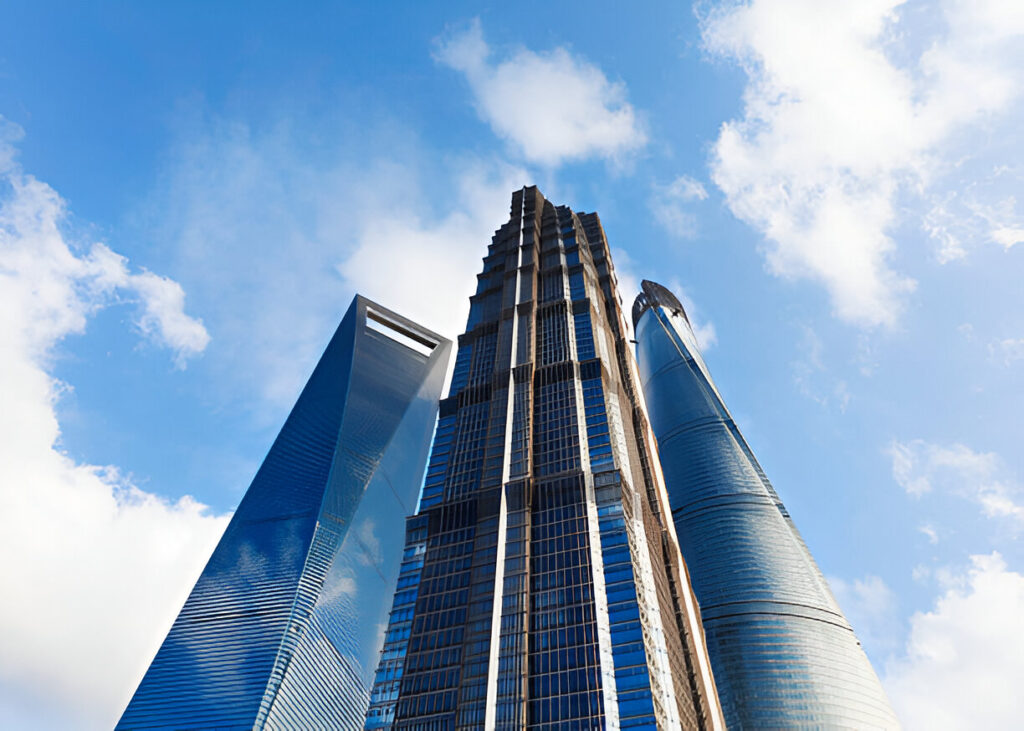Understanding Skyscraper Fundamentals
When learning about skyscrapers, it’s important to focus on their history, notable features, and how they evolved over time. This includes looking at early designs and current construction techniques.
Evolution of Skyscrapers
The history of skyscrapers dates back to 1885 with the construction of the Home Insurance Building in Chicago. This was considered the first skyscraper, standing at 10 stories high. It utilized a steel frame, which set a new trend for future tall buildings.
Over the years, skyscrapers evolved with architectural styles such as Art Deco and International Style emerging. These allowed for new designs and materials. As cities grew, the need for high-rise buildings increased, leading to taller and more impressive structures.
Defining Skyscraper Attributes
Skyscrapers are characterized by their height and innovative architecture. They often reach 150 meters or more, a necessity as urban land becomes scarce. Steel and reinforced concrete are common materials due to their strength and durability.
Art Deco buildings boast decorative elements, while International Style skyscrapers focus on minimalism. These buildings require careful design to withstand forces like wind. Skyscrapers redefine city skylines and represent human ambition and technological advancement.
Designing the Modern Skyscraper
When you think about modern skyscrapers, consider both the architectural style and the engineering that make these tall structures stand out. Key elements include design considerations and innovations that keep them safe, functional, and aesthetically pleasing.
Architectural Considerations
Creating a modern skyscraper involves addressing key design considerations. First, the building must be visually appealing while harmonizing with its surroundings. You often see sleek glass facades that define many skyscrapers today.
Besides aesthetic appeal, they need to have structural integrity. Engineers work to ensure the skyscraper can withstand heavy winds and potential earthquakes. Setbacks are often used to help distribute the weight and allow for more light and air at street level.
Environmental factors are also crucial. Modern buildings incorporate energy-efficient features like solar panels and green roofs. By considering these elements, architects create skyscrapers that are both beautiful and practical.
Innovations in Skyscraper Design
Innovation plays a big role in how skyscrapers are built. New materials, like high-strength concrete and advanced steel, allow for taller buildings than ever before. Engineering advancements help in crafting buildings that sway minimally in the wind.
Many modern skyscrapers feature smart building systems. These systems adjust lighting, heating, and cooling based on occupancy, improving energy efficiency. You also see design elements like double-skin facades to enhance insulation and reduce energy use.
Modular construction is another trend, speeding up building times and cutting costs. Being at the forefront of technology and environmentally friendly design is often the goal for those designing the tallest skyscrapers today.
The Anatomy of Skyscrapers
The anatomy of skyscrapers revolves around sturdy steel skeletons, vertical columns, and solid foundations. These elements form the backbone of the tallest buildings you see around the world.
The Steel Skeleton
The core of a skyscraper is its steel skeleton. This framework is made from interconnected steel beams and columns. Steel is chosen because it is strong and flexible, allowing buildings to withstand winds and other forces. This skeleton supports the structure’s weight and helps keep it stable. You can think of it like the bones in your body, which give shape and support.
This steel frame construction method started in the late 19th century. It allowed buildings to reach new heights. Before that, walls had to bear the weight, which limited how tall buildings could be. With steel skeletons, skyscrapers can rise hundreds of meters into the air, transforming city skylines.
Vertical Columns and Horizontal Beams
Vertical columns act as the main supports in a skyscraper. These columns, made of steel, stretch from the ground up through all floors. They help to evenly distribute the building’s weight and transfer it to the ground. Alongside these columns are horizontal beams. These beams connect the columns and form the floors.
Together, columns and beams form a structure called a “tube frame.” This design is efficient and reduces the amount of steel needed. Skyscrapers using this system can handle not just their weight but also forces like gravity and wind.
Foundations and Substructures
A skyscraper’s stability heavily depends on its foundation and substructure. The foundation is the part of the building below ground. It anchors the skyscraper and supports its massive weight. This part is usually made of reinforced concrete, known for its strength.
Before any construction begins, engineers study the ground. They determine how deep and strong the foundation needs to be. Substructures are like the base layer of the building. They include basements and other below-ground elements, which help distribute weight and provide extra support.
Together, foundations and substructures ensure the skyscraper stands firm, no matter how tall.
Construction Process and Safety Measures
Building a skyscraper is a complex task involving careful planning, precise execution, and strict safety standards. From selecting a site to installing safety systems, many steps ensure both the stability and security of the structure. Attention to safety is critical throughout construction to protect workers and future occupants.
Building Skyscrapers Step by Step
When you start building a skyscraper, site selection is crucial. You need solid ground to support the giant structure. After this, the design phase begins, considering factors like height, shape, and purpose. Once the design is finalized, excavation and foundation preparation come next. This ensures stability and involves digging and laying a strong foundation.
After the foundation is set, you will see the steel frame being installed. This acts like the skeleton of the skyscraper, giving it support and shape. Once the frame is up, the building gets its external cladding, which includes the windows and outer panels. Finally, the interior finishes are completed, adding walls, floors, and utilities. Since high-altitude operations require the use of construction equipment, every step must be taken with caution to ensure the personal safety of construction workers.
Safety Standards in Construction
Safety is key throughout the building process. Workers need proper training and equipment to handle the challenges of working at great heights. Personal protective equipment (PPE), like helmets and harnesses, are vital. Special safety elevators also ensure safe transportation for workers and supplies on the site.
Earthquakes can be a threat to tall buildings. Therefore, implementing systems to withstand seismic activity is essential. Engineers design skyscrapers to sway with the movement rather than break. Regular inspections and maintenance also play a big role. By following strict safety standards, skyscrapers remain safe for everyone involved, from construction workers to future inhabitants.
Iconic Skyscrapers and Technological Advancements
In the ever-evolving world of skyscrapers, there are both amazing structures and incredible technologies that bring these giants to life. From the stunning skyline of New York City to the futuristic towers of Dubai, you will find both beauty and innovation.
Major Skyscrapers Around the World
When you think of famous skyscrapers, the Burj Khalifa in Dubai probably comes to mind. It’s the tallest building on Earth, reaching an incredible height of 828 meters. It towers over the city, offering amazing views and setting new standards for construction.
In New York City, the Empire State Building has been an icon since 1931. Once the tallest building, it remains a symbol of human ambition and design. Then there are the Petronas Towers in Kuala Lumpur, which were once the tallest, known for their unique twin-tower design.
Shanghai, Hong Kong, Guangzhou, and Wuhan also boast impressive skyscrapers, each contributing to the world’s changing skylines. Together, these towers show the power and potential of real estate when mixed with creativity and engineering.
Technology’s Role in Skyscrapers
Building skyscrapers wouldn’t be possible without modern technology. Advanced engineering makes sure these tall buildings can stand tall and withstand strong winds. Innovations like high-speed elevators mean you can reach the top floors quickly and safely.
In tall structures like the Jeddah Tower, set to rise above 1,000 meters, technology plays a vital role. Materials such as reinforced steel and special glass help these buildings handle environmental challenges, while smart systems make them more energy-efficient.
As you explore the world of skyscrapers, you’ll discover the incredible role that technology plays in shaping these architectural wonders, ensuring safety and function meet design and height.



